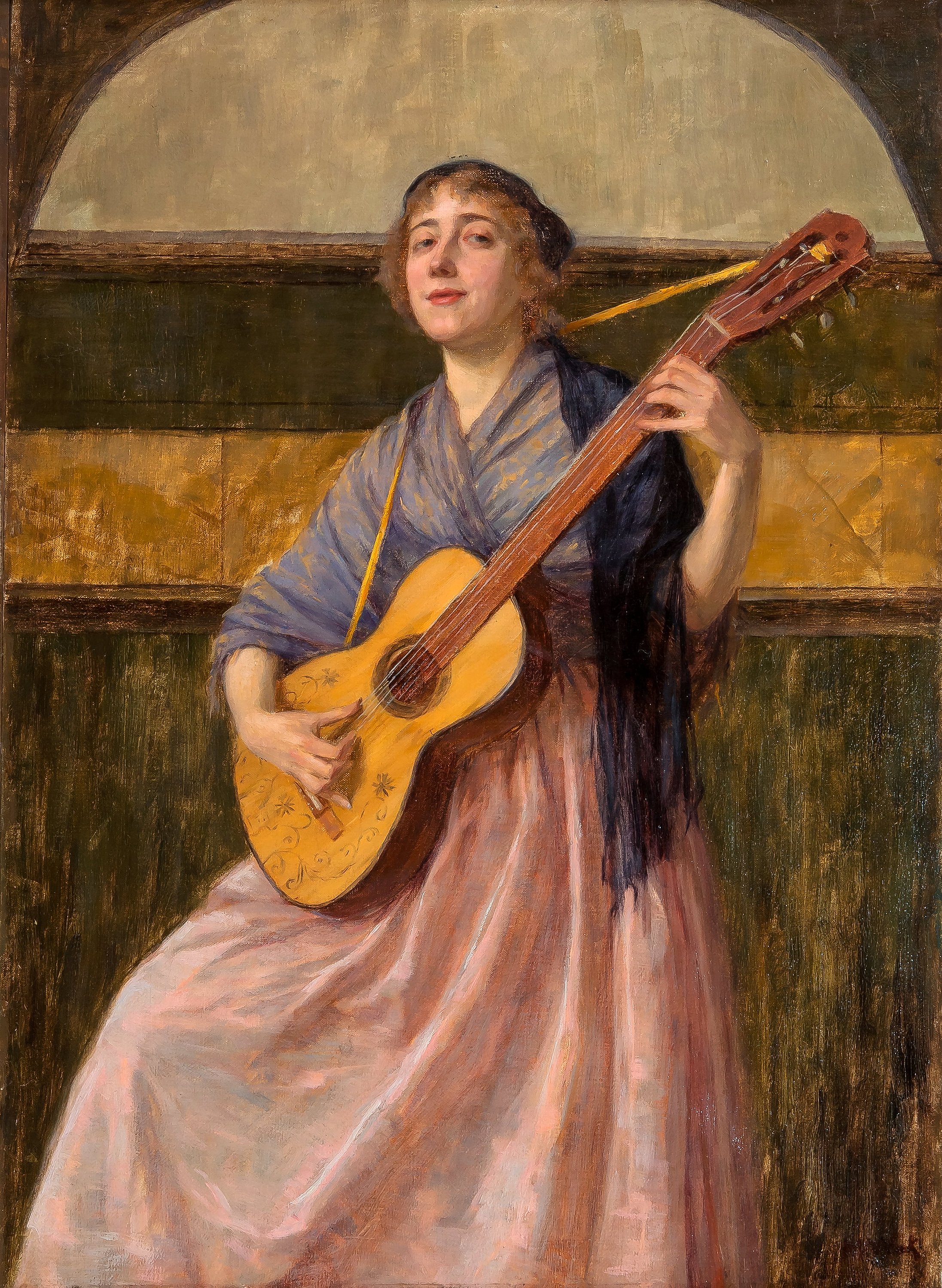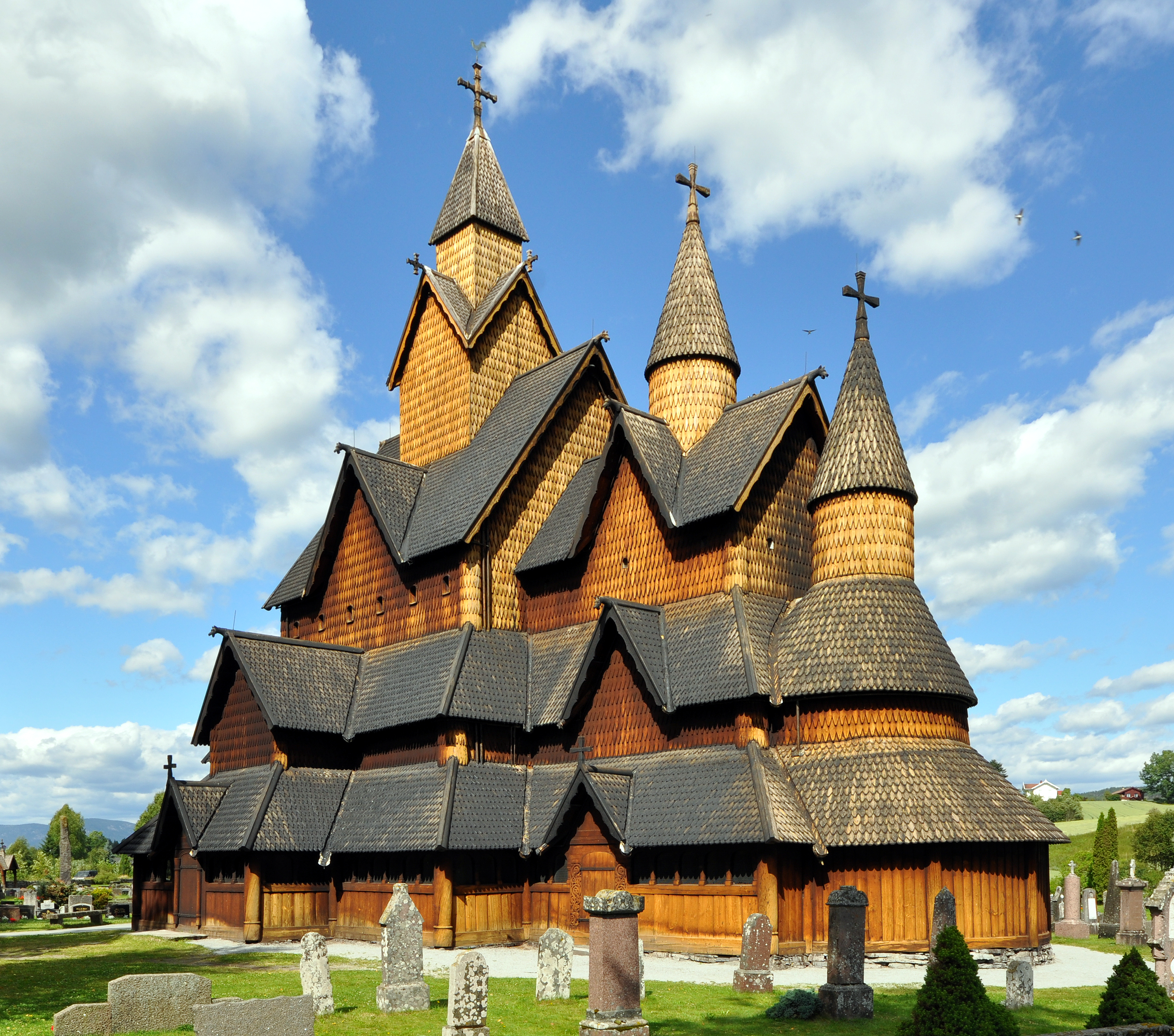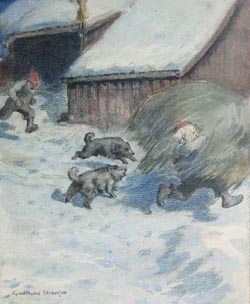|
Elvehøj
''Elvehøj'' (''Elf Hill'') is the Danish name of a Scandinavian ballad (''Danmarks gamle folkeviser'' no. 46), known in Swedish as ''Älvefärd'' (''Sveriges medeltida ballader'' no. 31), type A 65 ('knight released from elves at dawn') in ''The Types of the Scandinavian Medieval Ballad''; it is also attested in Norwegian. Summary The ballad is in the first person. The narrator, an attractive young man, falls asleep beside an elf-mound (or ''elvehøj''). Some women (usually elf-maidens) then attempt to woo the narrator, singing so beautifully that the natural world responds (the streams stop flowing, fish dance for joy, etc., depending on the variant). The narrator, however, resists their blandishments, grasping his sword (usually in silence). The man is most often rescued by the crowing of a cock awaking him, though in the Danish A-version, from the mid-sixteenth-century Jens Billes visebog (known to Grundtvig as 'Sten Bille’s Haandskrift'), he is saved by the advice of ... [...More Info...] [...Related Items...] OR: [Wikipedia] [Google] [Baidu] |
Elverhøj
''Elves' Hill'' () is a comedy by Johan Ludvig Heiberg (poet), Johan Ludvig Heiberg, with overture and incidental music by Friedrich Kuhlau (Op. 100), which is considered the first Danish national play. History ''Elves' Hill'' was commissioned by Frederick VI of Denmark, Frederik VI for the wedding of his daughter Princess Vilhelmine Marie of Denmark, Vilhelmine Marie and Frederik Carl Christian (later Frederik VII of Denmark, Frederik VII) and premiered on 6 November 1828, 5 days after the wedding. Since the premiere, the play has been performed more than 1,000 times at the Royal Danish Theatre. Story The work incorporated both the texts and melodies of two traditional ballad pieces featuring folklore about the Elven king. Heiberg localized the legend of the Elven king to Stevns Municipality, Stevns. To these, the motif element of the Changeling, swapped children was added. King Christian IV of Denmark, Christian IV is cast as a sort of detective, who unravels the mystery. Mu ... [...More Info...] [...Related Items...] OR: [Wikipedia] [Google] [Baidu] |
Danmarks Gamle Folkeviser
''Danmarks gamle Folkeviser'' is a collection of (in principle) all known texts and recordings of the old Danish popular ballads. It drew both on early modern manuscripts, such as Karen Brahes Folio, and much more recent folk-song collecting activity. It was started in 1853 by Svend Grundtvig. During the nineteenth century, Axel Olrik was also heavily involved, editing volumes 6-8. The work was continued in the twentieth century by new generations of folklorists, and in 1976 comprised 12 volumes, containing 539 ballad types, often with many variants of each type. Grundtvig's division of the ballad types into categories has mostly been adopted in later ballad collections, e.g. by F. J. Child, and by modern researchers in the field. However, many of the ballads he classed as 'historic' now have been reclassified. Grundtvig's classifications were: * Kæmpeviser (heroic songs) (vol. 1) * Trylleviser (magical songs) (vol. 2) * Historiske viser (historical songs) (vol. 3) * Ridderv ... [...More Info...] [...Related Items...] OR: [Wikipedia] [Google] [Baidu] |
The Types Of The Scandinavian Medieval Ballad
''The Types of the Scandinavian Medieval Ballad: A Descriptive Catalogue'' (TSB) is the designation for a cataloguing system for Scandinavian ballads. It is also the title of the underlying reference book: ''The Types of the Scandinavian Medieval Ballad: A Descriptive Catalogue'', edited by Bengt R. Jonsson, Svale Solheim and Eva Danielson, in collaboration with Mortan Nolsøe and W. Edson Richmond, published in 1978 in two places: as volume 5 of the series Skrifter utgivna av svenskt visarkiv (Stockholm: Svenskt visarkiv), and as volume 59 of series B of Oslo's Instituttet for sammenlignende kulturforskning (The Institute for Comparative Research in Human Culture) (Oslo, Bergen, and Tromsø: Universitetsforlaget; ). It attempts to classify all specimens of traditional ballads known in one or more of the Scandinavian languages ( Danish, Norwegian, Swedish, Icelandic, Faeroese, and the extinct Norn). Structure and scope Cognate ballads are assigned the same "TSB No." such ... [...More Info...] [...Related Items...] OR: [Wikipedia] [Google] [Baidu] |
Jens Billes Visebog
Jens Billes visebog ('Jens Bille's song-book', Odense, Landsarkivet for Fyn, Karen Brahe E I,2, also called 'Jens Billes håndskrift' and 'Jens Billes poesiebog' and once known as 'Steen Billes Haandskrift') is the second oldest major collection of Danish poetry, after the Heart Book. It was compiled in the second half of the 1550s. Format The manuscript is a small quarto in size (20×14½cm), paper, with 162 folios, all with the same watermark. The manuscript contains 87 poems written in around 17 different hands of which the most important are those of Jens Bille (1531–75), Sten Clausen Bille, and Anne Skave; they are numbered in pencil by Svend Grundtvig. It is from Jens Bille, who named himself in the manuscript as its owner, that the manuscript takes its modern name. Poems 1-86 were written in the period 1555–89, and poem 87, on the death of Frederick II of Denmark, in 1589. Contents The book contains some of our earliest attestations of Scandinavian ballads, such as ... [...More Info...] [...Related Items...] OR: [Wikipedia] [Google] [Baidu] |
Danmarks Gamle Folkeviser
''Danmarks gamle Folkeviser'' is a collection of (in principle) all known texts and recordings of the old Danish popular ballads. It drew both on early modern manuscripts, such as Karen Brahes Folio, and much more recent folk-song collecting activity. It was started in 1853 by Svend Grundtvig. During the nineteenth century, Axel Olrik was also heavily involved, editing volumes 6-8. The work was continued in the twentieth century by new generations of folklorists, and in 1976 comprised 12 volumes, containing 539 ballad types, often with many variants of each type. Grundtvig's division of the ballad types into categories has mostly been adopted in later ballad collections, e.g. by F. J. Child, and by modern researchers in the field. However, many of the ballads he classed as 'historic' now have been reclassified. Grundtvig's classifications were: * Kæmpeviser (heroic songs) (vol. 1) * Trylleviser (magical songs) (vol. 2) * Historiske viser (historical songs) (vol. 3) * Ridderv ... [...More Info...] [...Related Items...] OR: [Wikipedia] [Google] [Baidu] |
Skáld (band)
Skáld (stylised as SKÁLD) is a French Nordic folk group formed in 2018. Their songs bear a heavy Scandinavia, Norse influence, making use of traditional instruments and the themes they treat are mostly centred on Scandinavian culture, especially on Norse mythology and they use mostly Nordic languages, particularly Old Norse. History Origins The band was formed in 2018 by producer Christophe Voisin-Boisvinet, together with singers and musicians Justine Galmiche, Pierrick Valence, and Mattjö Haussy. They aimed to tell Nordic myths and legends singing mainly in Old Norse. The name "Skáld" comes from the Old Norse for "skald": a poet who composed skaldic poetry, usually in the courts during the Viking Age. In August 2018, their first Extended play, EP was released, featuring three songs: ''Gleipnir'', ''Ódinn'', and ''Rún.'' These three tracks were later included in their first album, released on 25 January 2019 by Decca: ''Vikings Chant''. This album was re-issued with t ... [...More Info...] [...Related Items...] OR: [Wikipedia] [Google] [Baidu] |
Ballad
A ballad is a form of verse, often a narrative set to music. Ballads were particularly characteristic of the popular poetry and song of Great Britain and Ireland from the Late Middle Ages until the 19th century. They were widely used across Europe, and later in Australia, North Africa, North America and South America. While ballads have no prescribed structure and may vary in their number of lines and stanzas, many ballads employ quatrains with ABCB or ABAB rhyme schemes, the key being a rhymed second and fourth line. Contrary to a popular conception, it is rare if not unheard-of for a ballad to contain exactly 13 lines. Additionally, couplets rarely appear in ballads. Many ballads were written and sold as single-sheet Broadside (music), broadsides. The form was often used by poets and composers from the 18th century onwards to produce lyrical ballads. In the later 19th century, the term took on the meaning of a slow form of popular love song and is often used for any love song ... [...More Info...] [...Related Items...] OR: [Wikipedia] [Google] [Baidu] |
Danish Folklore
Danish folklore consists of folk tales, legends, songs, music, dancing, popular beliefs, myths and traditions communicated by the inhabitants of towns and villages across the country, often passed on from generation to generation by word of mouth. As in neighbouring countries, interest in folklore grew with an emerging feeling of national consciousness in 19th century Denmark. Researchers travelled across the country collecting innumerable folktales, songs and sayings while observing traditional dress in the various regions. Folklore today is part of the national heritage, represented in particular by national and local traditions, songs, folk dances and literature. History As in the rest of Europe, interest in Danish folklore was a result of national and international trends in the early 19th century. In particular, the German Romanticism movement was based on the belief that there was a relationship between language, religion, traditions, songs and stories and those who pra ... [...More Info...] [...Related Items...] OR: [Wikipedia] [Google] [Baidu] |
Siren (mythology)
In Greek mythology, sirens () are female humanlike beings with alluring voices; they appear in a scene in the ''Odyssey'' in which Odysseus saves his crew's lives. Roman poets place them on some small islands called Sirenum scopuli. In some later, rationalized traditions, the literal geography of the "flowery" island of Anthemoessa, or Anthemusa, is fixed: sometimes on Cape Pelorum and at others in the islands known as the Sirenuse, near Paestum, or in Capreae. All such locations were surrounded by cliffs and rocks. Sirens continued to be used as a symbol of the dangerous temptation embodied by women regularly throughout Christian art of the medieval era. "Siren" can also be used as a slang term for a woman considered both very attractive and dangerous. Nomenclature The etymology of the name is contested. Robert S. P. Beekes has suggested a Pre-Greek origin. Others connect the name to σειρά (''seirá'', "rope, cord") and εἴρω (''eírō'', "to tie, join, faste ... [...More Info...] [...Related Items...] OR: [Wikipedia] [Google] [Baidu] |
Scandinavian Folklore
Nordic folklore is the folklore of Denmark, Norway, Sweden, Iceland and the Faroe Islands. It has common roots with, and has been under mutual influence with, folklore in England, Germany, the Low Countries, the Baltic countries, Finland and Sápmi. Folklore is a concept encompassing expressive traditions of a particular culture or group. The peoples of Scandinavia are heterogenous, as are the oral genres and material culture that has been common in their lands. However, there are some commonalities across Scandinavian folkloric traditions, among them a common ground in elements from Norse mythology as well as Christian conceptions of the world. Among the many tales common in Scandinavian oral traditions, some have become known beyond Scandinavian borders – examples include The Three Billy Goats Gruff and The Giant Who Had No Heart in His Body. Legends * Tróndur was a powerful Viking chieftain who lived in the Faroe Islands during the 9th century. According to legend, T ... [...More Info...] [...Related Items...] OR: [Wikipedia] [Google] [Baidu] |
Norwegian Folklore
Nordic folklore is the folklore of Denmark, Norway, Sweden, Iceland and the Faroe Islands. It has common roots with, and has been under mutual influence with, folklore in English folklore, England, German folklore, Germany, the Folklore of the Low Countries, Low Countries, the Baltic countries, Finland and Sápmi. Folklore is a concept encompassing expressive traditions of a particular culture or group. The peoples of Scandinavia are heterogenous, as are the oral genres and material culture that has been common in their lands. However, there are some commonalities across Scandinavian folkloric traditions, among them a common ground in elements from Norse mythology as well as Christian conceptions of the world. Among the many tales common in Scandinavian oral traditions, some have become known beyond Scandinavian borders – examples include Three Billy Goats Gruff, The Three Billy Goats Gruff and The Giant Who Had No Heart in His Body. Legends * Tróndur í Gøtu, Tróndur was ... [...More Info...] [...Related Items...] OR: [Wikipedia] [Google] [Baidu] |
Swedish Folklore
Nordic folklore is the folklore of Denmark, Norway, Sweden, Iceland and the Faroe Islands. It has common roots with, and has been under mutual influence with, folklore in England, Germany, the Low Countries, the Baltic countries, Finland and Sápmi. Folklore is a concept encompassing expressive traditions of a particular culture or group. The peoples of Scandinavia are heterogenous, as are the oral genres and material culture that has been common in their lands. However, there are some commonalities across Scandinavian folkloric traditions, among them a common ground in elements from Norse mythology as well as Christian conceptions of the world. Among the many tales common in Scandinavian oral traditions, some have become known beyond Scandinavian borders – examples include The Three Billy Goats Gruff and The Giant Who Had No Heart in His Body. Legends * Tróndur was a powerful Viking chieftain who lived in the Faroe Islands during the 9th century. According to legend, Tr� ... [...More Info...] [...Related Items...] OR: [Wikipedia] [Google] [Baidu] |






